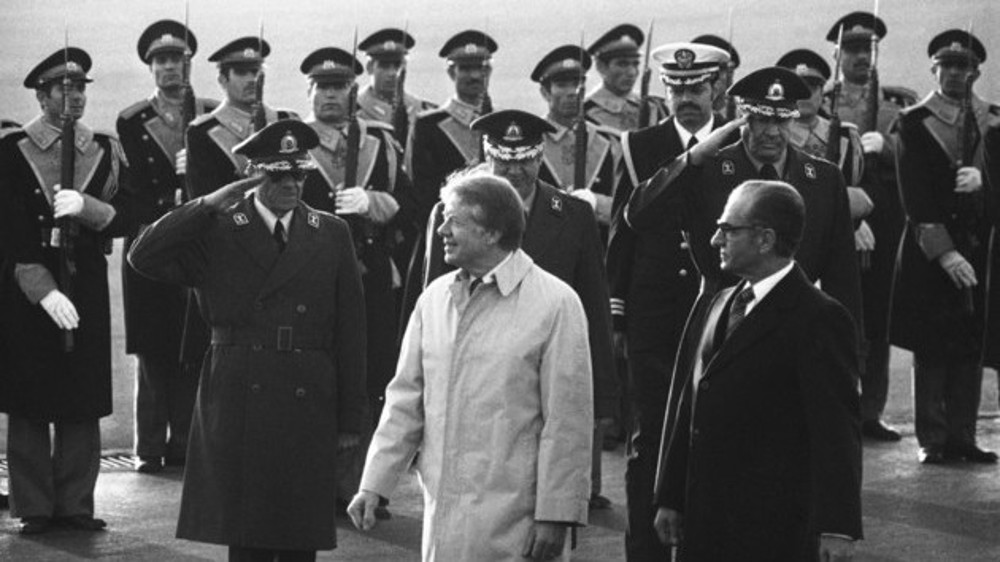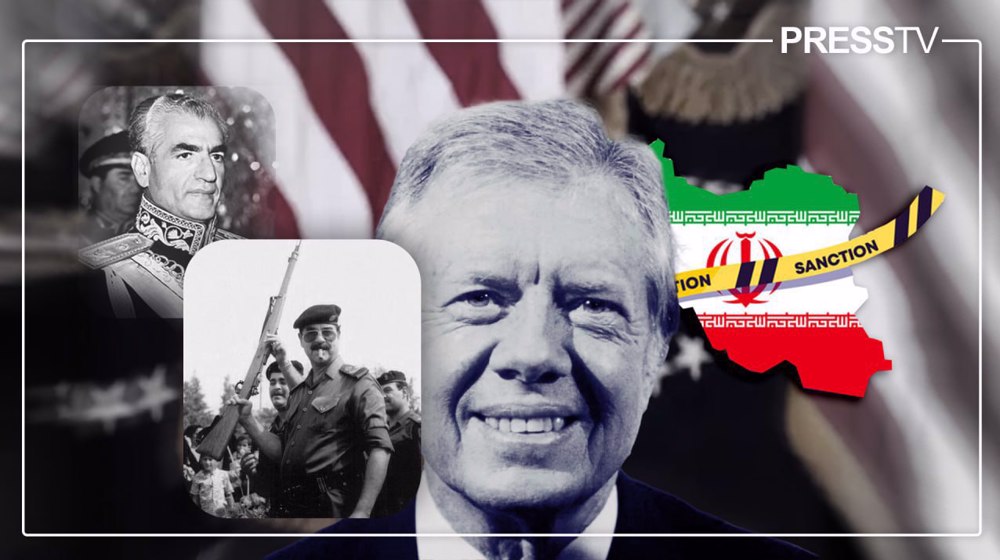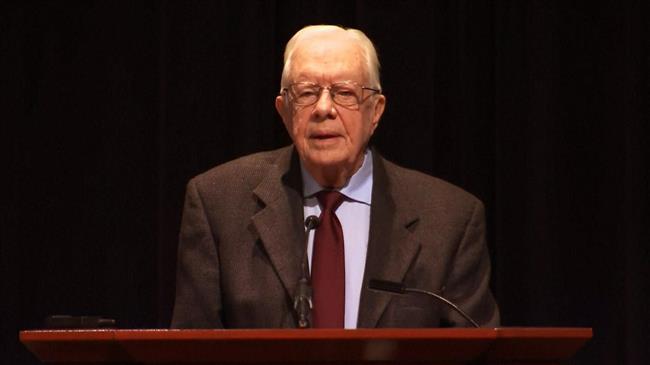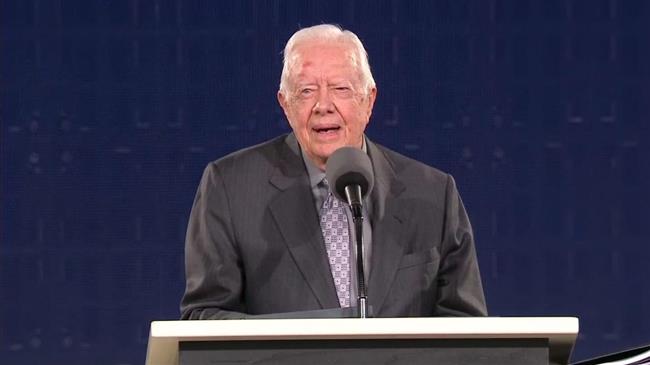Jimmy Carter and his tainted legacy of hostility toward Islamic Republic of Iran
By Ivan Kesic
Jimmy Carter will be remembered for his misguided and hostile policies that contributed to the escalation of tensions between Iran and the United States, leaving a tainted legacy that continues to shape geopolitics today.
James Earl Carter Jr., the 39th President of the United States, passed away at his home in Plains, Georgia, on December 29, just months after celebrating his centennial birthday.
The Islamic Revolution in Iran, one of the most important events of the 20th century, took place when he was at the helm in Washington. His tenure saw the US lose its most strategic puppet in West Asia.
Carter’s underestimation of the Iranian nation, coupled with a series of ill-conceived political maneuvers, led to the complete breakdown of already tenuous relations between the two nations.
Beyond his disastrous policy towards Tehran, Carter’s unwavering support for Israeli policies laid the groundwork for the ongoing Zionist aggression against Palestine, Lebanon, and the wider region.
Historians and political scientists agree that Carter's antagonistic stance towards the Islamic Republic played a decisive role in his defeat during the 1980 presidential election, denying him a second term.
His tenure, which began with his inauguration on January 20, 1977, ended on January 20, 1981, when Ronald Reagan assumed office.
Below, we examine key moments that defined Carter’s anti-Iran legacy.
Support for a puppet dictator
While Jimmy Carter professed a commitment to human rights in both domestic and international policies, his unwavering support for the corrupt and unpopular Pahlavi dictatorship in Iran told a very different story.
This regime, a product of the infamous Anglo-American coup of 1953, had long oppressed the Iranian people, yet Carter brazenly stood by its side.
In the midst of widespread unrest and rising discontent that foreshadowed the Islamic Revolution—a situation Carter was fully aware of—he made a high-profile visit to Tehran in late December 1977.
There, in a controversial Christmas Eve speech at Niavaran Palace, Carter delivered remarks that starkly contradicted the grim realities on the ground. He lauded Iran as "an island of stability in a turbulent region" and extolled Mohammed Reza Pahlavi as "a great ruler beloved by the people."
Carter went further, asserting that "no other country in the world was closer to the United States in terms of joint planning and addressing regional problems than Iran" and that "no other leader has a deeper respect and a more friendly relationship" with him.
These remarks, widely dismissed as misjudgments, were not merely naive—they were deliberate public stunts aimed at shoring up the regime's faltering legitimacy.
Despite Carter’s claims, intelligence reports in his possession clearly indicated the deep dissatisfaction of the Iranian populace with the West-backed ruler.
His attempt to paint Pahlavi’s regime as an indispensable partner of the United States backfired spectacularly. Instead of fostering goodwill, the visit ignited a series of anti-American protests.
Demonstrations erupted in 10 of Tehran’s 12 districts and spread to other cities, intensifying the wave of dissent that ultimately swept the Shah from power.
American flags will fly at half-mast for 30 days following the death of former US President Jimmy Carter at the age of 100. pic.twitter.com/42iQKzOOcr
— Press TV 🔻 (@PressTV) December 30, 2024
Plotting for the vassal regime
The fall of the Pahlavi regime did little to alter Washington’s determination to keep Iran under its influence. Classified intelligence documents, unearthed after the revolutionary students took over the Den of Espionage (the former US embassy in Tehran), exposed Washington’s plans to either sustain the dictatorship or replace it with another pliant, pro-Western regime.
These revelations laid bare the Carter administration’s blatant disregard for the aspirations of the Iranian people.
The revolutionary authorities, elected through a national referendum, were dismissed outright by Washington as unworthy of serious engagement. Instead, the sole focus remained on securing oil supplies and countering Soviet influence in the region through an authoritarian client state.
In the chaotic hours of the embassy siege, US personnel scrambled to destroy classified materials using paper shredders. However, their efforts were in vain.
Revolutionary students uncovered the shredded documents, which were meticulously reconstructed by Iran's skilled carpet weavers.
The restored files, now published in multiple volumes and available to the public, provide irrefutable evidence of Washington’s malign interference in Iran’s internal affairs.
The embassy takeover, carried out by revolutionary students in response to these hostile maneuvers, stands as one of the most successful counterintelligence operations in modern history.
It revealed the extent of foreign plotting against Iran and solidified the nation's resolve to resist external domination.
Freezing Iranian assets
The Carter administration was instrumental in initiating sanctions against Iran, marking the beginning of a policy that would define US-Iran relations for decades.
This campaign of economic warfare started with the freezing of Iranian assets and a trade embargo immediately after the Shah’s flight from Iran.
One of the most contentious issues in Iranian-American negotiations in 1979 was the return of $16 billion in frozen Iranian assets, a sum that today is valued at tens of billions of dollars.
Instead of demonstrating goodwill, Washington resorted to delay tactics and empty promises, offering no genuine intent to resolve the matter.
This financial impasse became one of the primary catalysts for the student-led siege of the American embassy in Tehran.
In response, Carter escalated the confrontation, issuing an executive order just ten days later to further freeze and block Iran’s assets. This move not only deepened the diplomatic crisis but also showcased Washington's aggressive posture toward Iran.
The executive order barred the transfer of any properties linked to the Shah or Iranian state assets held in US treasury accounts and banks.
While the Carter administration framed these sanctions as a reaction to the embassy seizure, the reality was starkly different: the sanctions had already been a cornerstone of US policy before the embassy takeover.
To justify his actions, Carter invoked the International Emergency Economic Powers Act (IEEPA), a law enacted two years earlier to preempt large-scale withdrawals of foreign assets from US banks.
Iran eventually took legal action, suing the US at the International Court of Justice (ICJ) in The Hague. In a landmark ruling last year, the ICJ ruled in favor of Tehran and ordered Washington to pay compensation, exposing the long-standing injustice.

Providing sanctuary to a deposed dictator
Initially hesitant, Carter opposed allowing the deposed Shah of Iran to enter the United States, fearing it would fuel anti-American sentiment in Iran.
As a result, Mohammed Reza Pahlavi spent the first months of his exile in other countries.
However, Carter later reversed his stance, permitting the Shah to receive medical treatment at New York’s Memorial Sloan Kettering Cancer Center on October 22, 1979.
This decision sparked outrage among the Iranian public, who interpreted it as another chapter in Washington's legacy of interference. For many Iranians, this move evoked fears of another US-orchestrated coup akin to the one in 1953.
The sanctuary provided to Pahlavi became one of the driving motivations for the revolutionary students who stormed the US embassy just 12 days later.
Along with demanding the unfreezing of Iranian assets, the students called for Pahlavi’s extradition to face justice for his crimes.
However, the Carter administration rejected these demands, granting Pahlavi a two-month stay before facilitating his peaceful exit to another host country.
Attempted military solutions to the crisis
The Carter administration's approach to its standoff with Tehran revealed a reluctance to prioritize diplomacy, instead leaning heavily on military interventions and covert operations.
On April 24, 1980, the US military launched a covert operation, codenamed Operation Eagle Claw, under Carter's orders.
The mission aimed to deploy eight helicopters carrying special forces from an aircraft carrier to a location near Tabas, Iran, where they would refuel and proceed to Tehran to rescue American hostages.
However, the mission ended in disaster due to a sandstorm and a collision between a helicopter and a plane. Eight American servicemen lost their lives, and five helicopters were abandoned.
Carter publicly took responsibility for the debacle.
Undeterred, Washington prepared two more operations, Honey Badger and Credible Sport, which also aimed to conduct air missions inside Iran. Neither was executed, as the failure of Operation Eagle Claw cast a long shadow over such plans.
In the same year, a more elaborate coup attempt—known as the Nojeh coup—was orchestrated by the Shah’s loyalists and American, Israeli, and Iraqi Baathist operatives.
The plot involved seizing an air base near Hamadan to launch deadly strikes against Iran’s leadership, aiming to create a power vacuum that could be filled by a pro-Western regime.
However, thanks to insider informants and vigilant counterintelligence, the Iranian authorities foiled the plan before it could be executed.
Last year, an Iranian court ordered the US government to pay $330 million in compensation to the families of the coup’s victims.
The verdict followed an exhaustive legal review, witness testimony, and examination of classified documents. The lawsuit, filed in August 2022, named the US government, the State Department, the Pentagon, the CIA, the Treasury Department, Boeing, and Jimmy Carter as defendants.
This case highlighted Washington's role in fomenting unrest in Iran and underscored the enduring consequences of Carter’s policies, which prioritized hegemonic ambitions over respect for national sovereignty.
Inciting Iraq to aggression and invasion
The Carter administration's most serious act of hostility against Iran, however, was inciting Baathist Iraq under Saddam Hussein to launch an aggression and invasion of Iran, thus beginning Iran's Sacred Defense war that lasted eight years and claimed hundreds of thousands of lives.
The then governments in Washington and Baghdad were convinced that Iran had been militarily weakened by the revolution and that both would quickly and easily achieve their goals through military intervention, forcing Tehran to make concessions.
Carter himself denied in his memoirs that he had any knowledge of the outbreak of war.
However, intelligence documents, the frequency of visits by American officials to Baghdad, and the timing of the start of the attack after unsuccessful Iranian-American negotiations in Germany testify that Washington both gave the green light and encouraged the aggression months earlier.
A key role among members of the Carter administration in this was played by Zbigniew Brzezinski, then US National Security Advisor.
China expands use of Iranian rail corridor for cargo transit
Ukraine’s Zelensky says open to dropping NATO bid for security guarantees
Israel kills 3 in south Lebanon as it threatens ‘wide-scale’ attack
VIDEO | Iran’s mega solar plant to power 2.5 million homes
Hamas warns against Israel's plans to 're-engineer' Gaza
VIDEO | South Koreans join migrants in Seoul to protest on Migrant Workers' Day
VIDEO | Press TV's news headlines
VIDEO | Iraq, UN officially mark end of UNAMI mission in country













 This makes it easy to access the Press TV website
This makes it easy to access the Press TV website